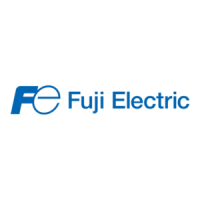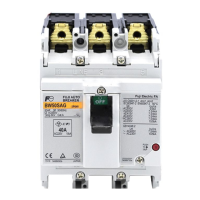Do you have a question about the Fuji Electric BW100EAG and is the answer not in the manual?
Overview of low-voltage circuit faults and protection measures.
Details on how circuit breakers protect against overload and short-circuit faults.
Explanation of phase-loss faults and protection methods for motors.
Types of overcurrent tripping and factors affecting them, including temperature.
Defines MCCB breaking performance, including capacity and let-through current.
Details on overload switching tests and conditions according to IEC standards.
Examines temperature rise and power consumption at rated current.
Covers switching durability and trip switching durability of MCCBs.
Details on power frequency and impulse withstand voltage performance.
Presents operating force and angle data for different MCCB types.
Lists key points to consider when selecting MCCBs for low-voltage circuits.
Explains conditions and criteria for cascade (backup) trip coordination.
Details selective trip coordination between breakers and with high-voltage devices.
Covers protection of wiring against overcurrents using MCCBs and thermal characteristics.
Discusses protection schemes for motors, including starting current considerations.
Addresses inrush current for transformer excitation and MCCB selection.
Explains characteristics and MCCB selection for arc and resistance welders.
Covers arc reignition, inrush current, and MCCB selection for capacitor circuits.
Discusses faults, overcurrents, and MCCB selection for thyristor converters.
Provides combinations for protecting Solid State Contactors (SSCs) using MCCBs or MMSs.
Details MCCB selection for protecting inverter circuits, emphasizing system and terminal protection.
Explains limitations of MCCB types for high frequency circuits and recommendations.
Covers MCCB usage in DC circuits, including operating characteristics and DC-specific models.
Provides guidelines for selecting MCCBs for UPS systems, considering overload withstand.
Lists MCCB types for servo amplifier applications, considering output and protective functions.
Explains grounding methods and ground fault protection for low-voltage systems.
Lists standard operating conditions for MCCB performance as per IEC 60947-1.
Discusses MCCB application in special environments like high temperature, humidity, cold, and altitude.
Covers precautions for connecting MCCBs, including reversed connection and tightening torque.
Explains how transient inrush current can cause malfunction and prevention methods.
Lists common MCCB faults and their possible causes and countermeasures.
Details initial and periodic inspection procedures and criteria for MCCBs.
Provides guidelines for MCCB deterioration diagnosis, replacement, and switching durability.
Covers the objective, formulas, and methods for calculating short-circuit current.
Explains how to create an impedance map by connecting current sources and impedances.
Describes series-parallel calculations to unify impedance on an impedance map.
Provides formulas to calculate symmetrical short-circuit current using the unified impedance.
Provides examples of transformer and cable impedance values for calculations.
Overview of low-voltage circuit faults and protection measures.
Details on how circuit breakers protect against overload and short-circuit faults.
Explanation of phase-loss faults and protection methods for motors.
Types of overcurrent tripping and factors affecting them, including temperature.
Defines MCCB breaking performance, including capacity and let-through current.
Details on overload switching tests and conditions according to IEC standards.
Examines temperature rise and power consumption at rated current.
Covers switching durability and trip switching durability of MCCBs.
Details on power frequency and impulse withstand voltage performance.
Presents operating force and angle data for different MCCB types.
Lists key points to consider when selecting MCCBs for low-voltage circuits.
Explains conditions and criteria for cascade (backup) trip coordination.
Details selective trip coordination between breakers and with high-voltage devices.
Covers protection of wiring against overcurrents using MCCBs and thermal characteristics.
Discusses protection schemes for motors, including starting current considerations.
Addresses inrush current for transformer excitation and MCCB selection.
Explains characteristics and MCCB selection for arc and resistance welders.
Covers arc reignition, inrush current, and MCCB selection for capacitor circuits.
Discusses faults, overcurrents, and MCCB selection for thyristor converters.
Provides combinations for protecting Solid State Contactors (SSCs) using MCCBs or MMSs.
Details MCCB selection for protecting inverter circuits, emphasizing system and terminal protection.
Explains limitations of MCCB types for high frequency circuits and recommendations.
Covers MCCB usage in DC circuits, including operating characteristics and DC-specific models.
Provides guidelines for selecting MCCBs for UPS systems, considering overload withstand.
Lists MCCB types for servo amplifier applications, considering output and protective functions.
Explains grounding methods and ground fault protection for low-voltage systems.
Lists standard operating conditions for MCCB performance as per IEC 60947-1.
Discusses MCCB application in special environments like high temperature, humidity, cold, and altitude.
Covers precautions for connecting MCCBs, including reversed connection and tightening torque.
Explains how transient inrush current can cause malfunction and prevention methods.
Lists common MCCB faults and their possible causes and countermeasures.
Details initial and periodic inspection procedures and criteria for MCCBs.
Provides guidelines for MCCB deterioration diagnosis, replacement, and switching durability.
Covers the objective, formulas, and methods for calculating short-circuit current.
Explains how to create an impedance map by connecting current sources and impedances.
Describes series-parallel calculations to unify impedance on an impedance map.
Provides formulas to calculate symmetrical short-circuit current using the unified impedance.
Provides examples of transformer and cable impedance values for calculations.
| Poles | 3 |
|---|---|
| Rated Current (A) | 100 |
| Voltage rating | 415VAC |
| Frequency | 50/60 Hz |
| Trip mechanism | Thermal-Magnetic |
| Mounting type | Fixed |
| Breaking capacity | 30kA |










